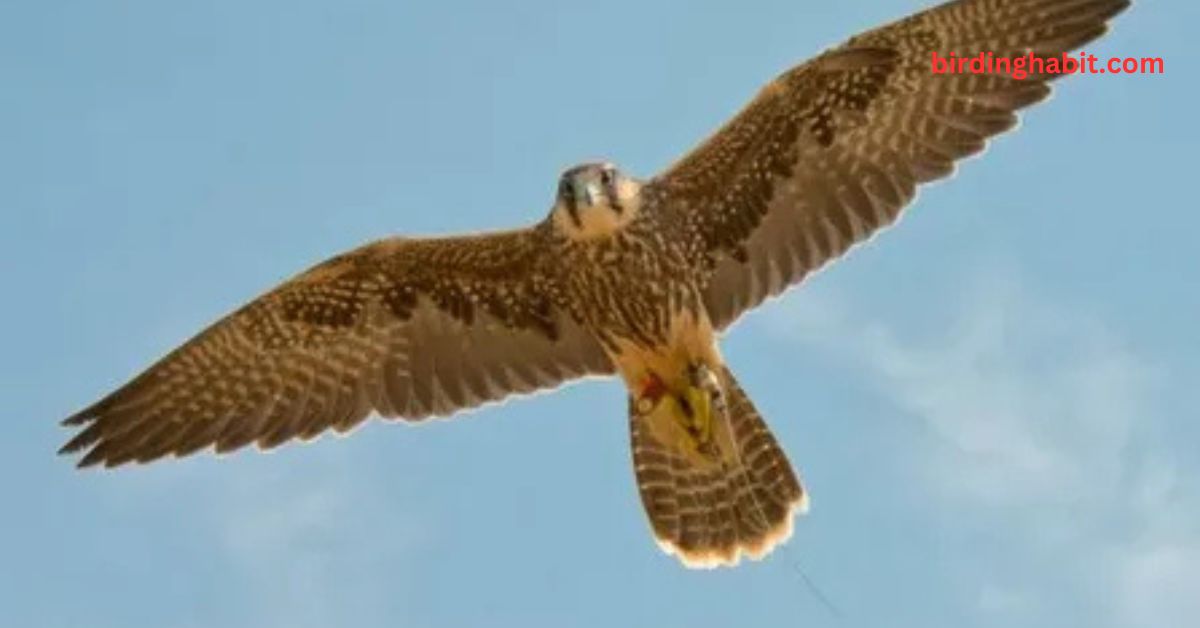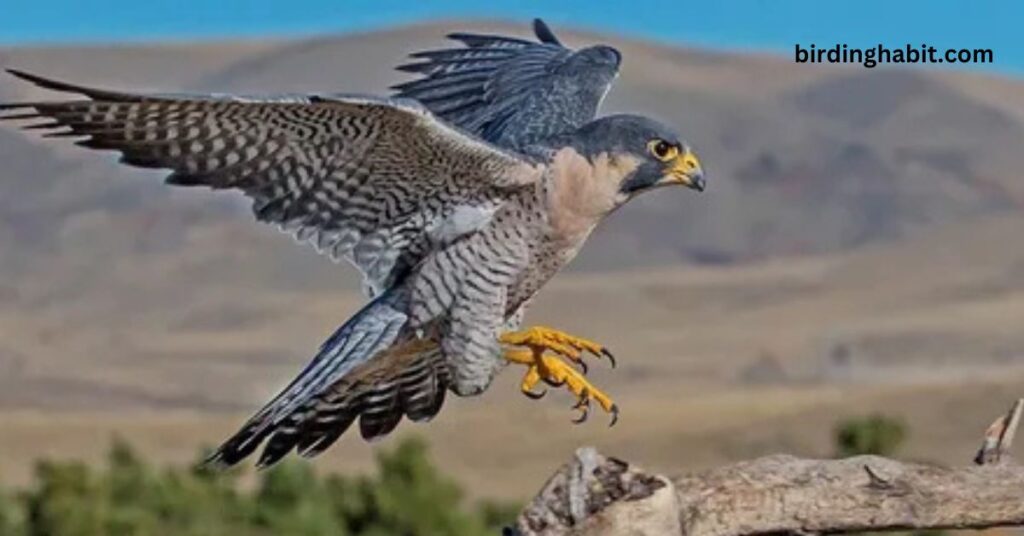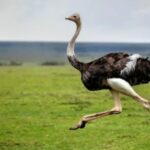The peregrine falcon (Falco peregrine’s) is often regarded as the fastest bird in the world — in fact, it holds the title of the fastest animal on the planet, reaching speeds of over 240 miles per hour (386 kilometers per hour) during its iconic hunting stoop, or dive.
But what exactly makes this bird so fast? Let’s explore the fascinating biology, aerodynamics, and unique behaviors that contribute to the peregrine falcon’s extraordinary speed.
Peregrine falcons are found all over the world, from the Arctic to tropical regions, though they tend to prefer open spaces such as coastal cliffs, mountain ranges, and increasingly, urban environments.
Their adaptability to cities, where they nest on tall buildings or bridges, has allowed them to thrive in places where other raptors might struggle.
With a wingspan that ranges from 3 to 4 feet (0.9 to 1.2 meters) and a sleek, aerodynamic body, peregrine falcons are built for high-speed pursuit.
Their plumage is typically a bluish-gray on the back with a white or pale underside, and they often display a distinctive black “moustache” mark on their face, adding to their striking appearance.
1. Aerodynamic Body Structure
One of the key features that allow the peregrine falcon to reach such astonishing speeds is its aerodynamic body. The falcon’s sleek, streamlined shape minimizes air resistance, enabling it to move through the air with remarkable efficiency.
Its long, pointed wings and tapered tail not only help it maneuver quickly in flight but also allow it to cut through the air with minimal drag.
When diving, the peregrine falcon pulls its wings close to its body, further reducing its surface area and enhancing its ability to slice through the atmosphere. This technique, known as a “stoop,” involves the falcon folding its wings into a V-shape and descending in a high-speed plunge toward its prey.
2. Powerful Muscles and High-Performance Flight
The peregrine falcon is equipped with powerful flight muscles that provide it with explosive speed. These muscles, especially those attached to the wings, are highly developed to support rapid acceleration and sustained high-speed flight.
The falcon’s wings are designed to give it both speed and agility, with a high aspect ratio (the ratio of wing length to wing width), which allows it to generate lift while minimizing drag.
In addition to powerful muscles, peregrines have specialized air sacs in their chest that allow for more efficient oxygen exchange during flight, enabling them to maintain high speeds for longer periods.
This combination of muscle strength and specialized physiology is key to their ability to reach extreme velocities during their hunts.
3. Keen Vision and Precision Hunting
The peregrine falcon’s hunting speed is aided by its exceptional vision. With eyesight that’s 8 to 10 times sharper than that of a human, peregrines can spot potential prey from great distances — sometimes over two miles away.
This keen eyesight is crucial during a high-speed stoop, as the falcon must accurately target its prey while plummeting at extreme speeds.
The falcon uses its vision to lock onto its target and adjust its flight path with incredible precision. It can even calculate and anticipate the movement of prey mid-dive, making adjustments to its angle of descent to ensure a successful strike.
This incredible combination of speed and accuracy is what makes the peregrine falcon such a formidable hunter.
How Do Falcons Use Their Exceptional Vision for Hunting?
Falcons, renowned for their incredible speed and agility, also possess one of the most advanced visual systems in the animal kingdom.
Their exceptional vision plays a crucial role in their hunting success, allowing them to spot prey from great distances, make rapid decisions, and execute precise strikes at high speeds.
Here’s a closer look at how falcons use their remarkable eyesight to become some of the most efficient hunters in the bird world.
1. Superior Visual Acuity
Falcons have eyesight that is 8 to 10 times sharper than that of humans. This means they can detect even the smallest movement of potential prey from miles away.
This extraordinary visual acuity is due to a higher number of photoreceptor cells in their retinas — specifically, cone cells, which are responsible for sharp, detailed vision.
For comparison, while humans have around 200,000 cone cells per square millimeter of the retina, falcons can have as many as 1,000,000 cone cells per square millimeter. This high concentration of cones allows them to see fine details at great distances.
2. Color Vision and Ultraviolet Sensitivity
Not only do falcons have exceptional sharpness, but their vision also extends beyond human capabilities in terms of color perception. Falcons can see a broader spectrum of colors, including ultraviolet (UV) light.
This ability gives them a unique advantage in tracking prey. Many animals, especially smaller birds, reflect UV light in their feathers, and falcons can use this to differentiate between species, detect prey in complex environments, or even spot camouflaged animals.
For instance, certain prey animals may leave UV-reflective trails that help falcons track their movements through the environment.
3. Binocular Vision for Depth Perception
Falcons possess excellent binocular vision, meaning both eyes work together to provide a single, focused image with a high degree of depth perception. This is especially important when they are swooping down on prey during a high-speed dive, known as a “stoop.”
Depth perception allows the falcon to judge the distance between itself and its prey, ensuring an accurate strike. This precise control is crucial when chasing fast-moving birds or other animals that may attempt to dodge or evade.
4. Foveal Vision for Sharp Focus
Falcons also have an advanced foveal region in their eyes. The fovea is the part of the retina responsible for sharp, detailed vision. In falcons, the fovea is highly developed and large, giving them the ability to focus on tiny details from long distances.
When a falcon is hunting, it can focus on a specific target, like a small bird flying hundreds of meters away, with exceptional clarity. This sharp focus is critical when targeting fast-moving prey at high altitudes.
5. Nictitating Membrane: Protection and Clarity
To protect their eyes during high-speed dives, falcons have a specialized, translucent eyelid called the nictitating membrane.
This membrane acts as a protective “third eyelid” that sweeps across the eye from side to side, providing a shield against the wind, debris, and the force of the dive. The membrane also helps maintain eye moisture and clarity, ensuring that the falcon’s vision remains sharp even during the intense physical strain of a stoop.
6. Why Is the Peregrine Falcon So Fast?
At its core, the peregrine falcon’s speed is an evolutionary advantage. Speed allows the peregrine to outmaneuver and surprise its prey, often capturing fast-flying birds, such as pigeons or ducks, mid-air.
The peregrine uses its incredible velocity to gain the upper hand in a pursuit, diving from a great height to strike before the prey even has a chance to react.Moreover, the falcon’s speed helps it avoid predators and competitors.
While peregrine falcons themselves are rarely preyed upon due to their speed and agility, their rapid flight also allows them to escape other threats, such as larger raptors or human encroachment.

7. Conservation and the Future of the Peregrine Falcon
While the peregrine falcon’s speed is truly awe-inspiring, the species has not always been so abundant. In the mid-20th century, peregrine populations suffered significant declines due to the widespread use of the pesticide DDT, which thinned their eggshells and caused reproductive failures.
However, thanks to conservation efforts, including the banning of DDT and the implementation of successful breeding programs, peregrine falcon numbers have rebounded.
Today, the peregrine falcon is no longer considered endangered and is found across many parts of the world, from urban skyscrapers to remote cliffs.
Conservationists continue to monitor the species’ population and work on preserving the habitats that sustain their incredible speed and hunting prowess.
Conclusion
The peregrine falcon is a remarkable example of nature’s ingenuity, combining extreme speed with razor-sharp vision, a specialized body structure, and powerful flight muscles to dominate the skies.
Its ability to reach speeds of over 240 miles per hour during a stoop makes it not only the fastest bird but also the fastest animal on Earth.
This incredible feat is the result of millions of years of evolutionary adaptation, allowing the peregrine falcon to be a true master of the air.
Whether it’s diving from great heights or gracefully soaring through the sky, the peregrine falcon continues to captivate and inspire with its unparalleled speed and hunting skills.
Historically, peregrine falcons faced significant population declines due to the widespread use of pesticides like DDT in the mid-20th century, which weakened their eggshells and hindered reproduction.
However, conservation efforts, including the banning of harmful chemicals and active breeding programs, have been highly successful in restoring their populations, particularly in North America and Europe.
Today, peregrine falcons can be found in a wide variety of habitats, from remote cliff faces to urban skyscrapers, where they have adapted to nesting in artificial structures.
Their resurgence stands as a testament to the power of conservation and the resilience of wildlife when given the proper protections.
The peregrine falcon continues to capture human fascination, not only for its speed and hunting prowess but also as a symbol of environmental recovery and the importance of biodiversity conservation.


